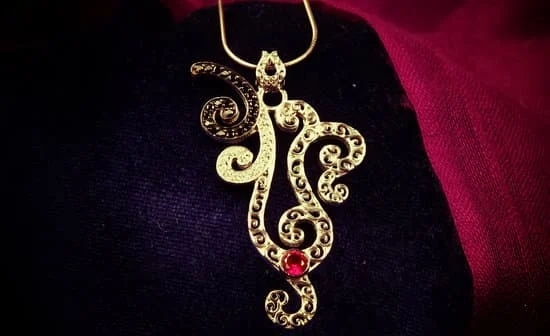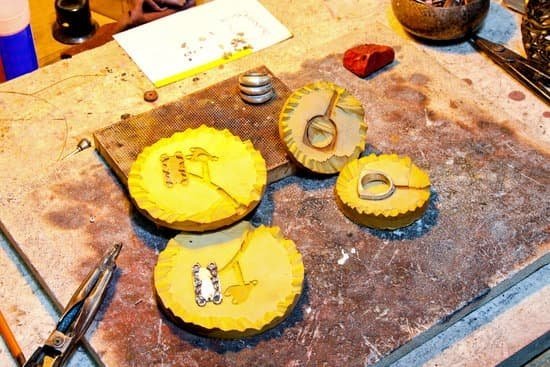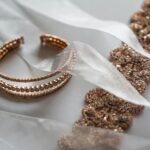The process of how diamonds are cut for jewelry is a meticulous and intricate journey that unveils the secrets behind the mesmerizing sparkle of diamond jewelry. It takes raw, uncut diamonds and transforms them into dazzling gemstones that captivate the beholder. Understanding this process is essential for appreciating the craftsmanship involved in creating stunning diamond jewelry.
Diamond cutting is a multifaceted process that involves several steps, each one crucial to achieving the perfect cut. From selecting the right diamond to shaping the rough stone, dividing it into separate pieces, creating the basic shape, and finally cutting and polishing its facets – every stage requires precision, skill, and advanced technologies.
Selecting the perfect diamond is the first step in this transformative journey. Raw diamonds are assessed based on criteria known as the Four Cs – Carat, Color, Clarity, and Cut. Each of these factors plays a significant role in determining both the value and quality of a diamond.
This article aims to break down the complex process of how diamonds are cut for jewelry into comprehensible steps. By delving into each stage’s intricacies and exploring how advanced technologies and skilled craftsmen contribute to their success, readers will gain a deeper appreciation for the mastery involved in creating these precious gemstones.
Understanding the Diamond Cutting Process
The process of diamond cutting may seem intricate and mysterious, but it can actually be broken down into several comprehensible steps. This section will delve into the various stages involved in transforming a raw diamond into a dazzling gemstone.
The first step in the diamond cutting process is selecting the perfect diamond. This involves assessing raw diamonds based on the Four Cs: Carat, Color, Clarity, and Cut. Carat refers to the weight of the diamond, while color and clarity determine its visual appearance. However, it is the cut that truly determines how well a diamond sparkles. Skilled professionals carefully examine raw diamonds to ensure they meet all the necessary criteria before moving on to the next stage.
Once a suitable diamond has been selected, it is time to shape the rough stone. Advanced technologies and skilled craftsmen come together in this stage to transform the rough diamond into a more refined form. Various tools and techniques are employed to carefully shape and remove any imperfections from the stone. This stage plays a crucial role in determining both the final shape and size of the diamond.
After shaping the rough stone, it is time for cleaving or sawing. This involves splitting the diamond into separate pieces using different methods such as laser cutting or traditional methods like cleaving with a specialized tool called a cleaver’s knife or sawing with a diamond blade saw machine. The chosen method depends on factors such as cleavage planes within the rough stone and desired final shapes.
These initial stages are just the beginning of the transformative journey that ultimately brings out the mesmerizing brilliance of a diamond jewelry piece. In future sections, we will explore further steps such as bruting – where diamonds are shaped into basic outlines – faceting – where multiple facets are precisely cut and polished – as well as adding final touches like cleaning and inspection.
Summary
- Understanding each stage in the diamond cutting process is essential in appreciating the craftsmanship and skill involved in creating stunning diamond jewelry.
- The first step involves selecting the right diamond based on the Four Cs: Carat, Color, Clarity, and Cut.
- Shaping the rough stone and dividing it through cleaving or sawing are crucial stages that determine the final shape and size of the diamond.
Selecting the Perfect Diamond
When it comes to creating stunning diamond jewelry, the first step in the intricate process of diamond cutting is selecting the perfect diamond. This crucial step involves assessing raw diamonds based on several criteria to ensure only the best diamonds are chosen for cutting.
One of the key factors taken into consideration during the selection process is the carat weight of the raw diamond. Carat weight refers to the size of the diamond and plays a significant role in determining its value. Larger diamonds are generally more valuable, but other factors such as cut and clarity also impact their worth.
The color of a diamond is another important factor considered during the selection process. Diamonds come in various shades, ranging from colorless to light yellow or brown. The most highly valued diamonds are those that are completely colorless, as they allow maximum light reflection and sparkle.
The clarity of a diamond refers to the presence of any internal or external flaws, known as inclusions or blemishes, respectively. During the selection process, diamonds with few or no visible flaws are preferred, as these flaws can affect the overall beauty and brilliance of the finished gemstone.
Last but not least, perhaps one of the most critical aspects when selecting a raw diamond for cutting is evaluating its cut quality. The cut determines how well a diamond interacts with light and affects its overall brilliance. A well-cut diamond allows light to enter through its top facets and reflect back out through those same surfaces, resulting in an exquisite display of sparkle.
By carefully considering these four criteria – carat weight, color, clarity, and cut – diamond cutters can ensure that only exceptional diamonds are chosen for further processing. Selecting top-quality diamonds sets a solid foundation for creating stunning jewelry pieces that will mesmerize anyone lucky enough to behold them.
Significance in the Selection Process
Each criterion carries equal importance in selecting a perfect diamond for cutting. However, it’s worth noting that some factors may carry more weight depending on the desired outcome or specific jewelry design.
For example, if a designer wants to create a large statement piece, they may prioritize a higher carat weight over other factors such as color or clarity. On the other hand, for delicate and intricate designs, the emphasis may shift to clarity and cut to ensure that every facet shines with brilliance.
Expertise of Diamond Cutters
Assessing raw diamonds for cutting is no easy feat and requires expert knowledge and experience. Diamond cutters are highly skilled professionals who have spent years honing their craft. They possess an in-depth understanding of how various factors interact with each other to produce a beautiful diamond.
These experts rely on their keen eye, extensive training, and state-of-the-art equipment to evaluate diamonds accurately. Through meticulous examination and evaluation using industry-standard grading systems, they can identify flaws, assess proportions, and determine how specific cuts will enhance the stone’s beauty. This expertise ensures that only the highest quality raw diamonds are selected for further processing in the journey of turning them into breathtaking gems.
In summary, selecting the perfect diamond is an essential initial step in the diamond cutting process. By considering factors such as carat weight, color, clarity, and cut quality, expert diamond cutters can ensure that only exceptional stones are chosen for cutting. Their expertise plays a pivotal role in setting the stage for creating mesmerizing jewelry pieces that showcase the sheer brilliance of these exquisite gemstones.
Shaping the Rough
Introduction to Shaping the Rough
Before a rough diamond can become a dazzling gemstone, it must go through several transformative stages. One of the most critical stages in the diamond cutting process is shaping the rough. This stage involves using specialized tools and techniques to give the rough diamond its initial form and structure.
The Tools and Techniques Used
Shaping the rough diamond requires a unique combination of skill, experience, and advanced technologies. Diamond cutters use a variety of tools to carefully shape the diamond according to predetermined specifications. One commonly used tool is a diamond cleaving blade or saw, which is used to split the rough into separate pieces. This process requires precision to ensure minimal waste and maximize the value of each diamond.
Another technique employed in shaping the rough is bruting. Bruting involves rotating two diamonds against each other on a spinning axle to grind their edges together. This grinding action helps create a basic outline or shape for the final gemstone. Skilled craftsmen monitor this process closely, as precision and symmetry are crucial at this stage.
The Role of Advanced Technologies and Skilled Craftsmen
While traditional manual techniques are still vital in shaping rough diamonds, advanced technologies have also played an increasingly significant role in recent years. Computer-aided design (CAD) software allows cutters to plan and visualize each step of the shaping process accurately. Laser technology has emerged as another valuable tool in creating intricate designs or custom shapes on diamonds.
Despite these technological advancements, skilled craftsmen remain an integral part of shaping rough diamonds. Their expertise in handling tools and their eye for detail ensure that each diamond achieves its optimal beauty potential.
Cleaving or Sawing
In the diamond cutting process, one of the crucial stages is cleaving or sawing, where the rough diamond is divided into separate pieces. This step requires precision and skill to ensure that the diamond is split accurately and efficiently.
There are different methods used to cleave a diamond, depending on factors such as its shape and size. One method is called “brute force.” In this technique, a steel blade with a sharp edge is used to make a deep groove along a plane of weakness within the rough diamond. Then, a quick and controlled strike is made on this groove, causing the diamond to cleave or split along that line.
Another method commonly used for larger diamonds is sawing. Specialized saws fitted with diamond-edged blades are used to cut through the rough diamond. This method allows for more control over the division process and can be preferred when precision cuts are necessary.
The choice between cleaving and sawing depends on several factors including the size of the rough diamond, its potential value after cutting, and any inclusions or flaws present within it. The aim during this stage is to divide the rough diamond into smaller pieces while maximising its potential value by minimizing wastage.
| Method | Description |
|---|---|
| Brute Force | A steel blade with a sharp edge is used to create a deep groove along a plane of weakness in the rough diamond. A quick strike then splits it precisely. |
| Sawing | Diamond-edged blades on specialized saws are used to carefully cut through the rough diamond, providing control over the division process. |
Cleaving or sawing has a significant impact on the final shape of the diamond. The process not only divides the rough diamond but also determines the potential shapes that can be achieved in subsequent stages of cutting and polishing. The decision of where and how to cleave or saw the diamond is crucial, as it sets the stage for creating a beautiful finished gemstone.
After the diamond is divided, careful consideration is made to determine which pieces will become individual gemstones and what shapes they will take. Skilled diamond cutters assess each piece based on various factors such as clarity, size, color, and any internal flaws. These assessments help determine how best to cut and shape each individual piece to maximize its brilliance and value.
Bruting
Bruting is a crucial stage in the diamond cutting process where the rough diamond is shaped into a basic outline. This step is essential to prepare the diamond for its final faceting and polishing stages. The art of bruting requires precision and symmetry to ensure that the diamond achieves its intended shape.
During bruting, two diamonds are placed in a rotating mechanism called a lathe or a scaif. These diamonds, known as girdle or bruiting diamonds, are used to shape the rough diamond by grinding against it. The rotation creates friction that gradually shapes the rough diamond into a desired outline.
The skilled craftsmen who perform bruting have years of experience and expertise in understanding the characteristics of diamonds and how they respond to different pressures during grinding. They carefully control the force with which the bruiting diamonds grind against the rough diamond to ensure minimal loss of weight and maximum efficiency in shaping.
Throughout the bruting process, continuous inspection is conducted to ensure that each facet’s alignment matches perfectly with its opposite counterpart. This plays an important role in achieving optimal symmetry and enhancing the overall appearance of the finished diamond.
Once bruting is completed, the rough diamond begins to take on a recognizable shape, such as round, oval, emerald, or marquise. It then proceeds to the next stage of faceting, where precise cutting and polishing create stunning facets that maximize brilliance and sparkle.
Faceting
The process of faceting is a crucial stage in diamond cutting where the rough diamond is transformed into a breathtaking gemstone. This intricate process involves cutting and polishing the diamond’s facets, which are the flat polished surfaces that give diamonds their sparkle and brilliance.
Faceting begins with the selection of the diamond’s shape. Common shapes include round brilliant, princess cut, emerald cut, and marquise cut, among others. Each shape requires a specific arrangement of facets to optimize its beauty and maximize its sparkle.
Once the shape is determined, skilled craftsmen use advanced technologies such as laser cutting and computer-aided design (CAD) to precisely calculate and mark where each facet will be placed on the diamond. This ensures that every facet is positioned at the correct angle and size to interact with light in a way that enhances the diamond’s brilliance.
The actual cutting and polishing of each facet requires great precision and skill. Diamond cutters use specialized tools such as scaives (diamond-bearing discs), laps (plates coated with diamond dust), and polishing compounds to gradually shape each facet by grinding away small amounts of material. Multiple steps are involved in achieving the desired shape and proportions for each individual facet.
The final result of this meticulous faceting process is a diamond that truly comes alive with unparalleled brilliance, fire, and scintillation. The carefully calculated angles and proportions allow light to enter the diamond, reflect off its internal surfaces, and return back through its top facets with intensity.
Adding the Final Touches
The final stage of the diamond cutting process involves adding the final touches to ensure the diamond is sparkling clean and meets the highest quality standards. This includes a meticulous cleaning process and rigorous inspection to ensure that the diamond is ready to be set into jewelry.
Cleaning a diamond is essential to remove any remaining impurities and restore its natural shine. One common method used is ultrasonic cleaning, where the diamond is placed in a specialized machine that uses high-frequency sound waves to loosen dirt and grime. Another method is steam cleaning, where pressurized steam is used to remove any stubborn residue from the diamond’s surface. After cleaning, the diamond is thoroughly rinsed with water and carefully dried.
Once the diamond has been cleaned, it undergoes a thorough inspection to ensure it meets the highest quality standards. Skilled gemologists examine the cut, color, clarity, and carat weight of the diamond under various lighting conditions to assess its overall beauty and value. They use specialized tools such as magnifying loupes and microscopes to closely examine every facet of the diamond.
During this inspection process, any imperfections or blemishes are carefully assessed, and decisions are made on whether they can be corrected or if they affect the overall quality of the stone. Any remaining flaws or rough edges are meticulously removed through further cutting and polishing techniques until a flawless finish is achieved.
| Process | Description |
|---|---|
| Cleaning | Meticulous process using ultrasonic or steam cleaning methods |
| Inspection | Gemologists examine cut, color, clarity, and carat weight with specialized tools |
| Correction | Imperfections and rough edges are removed through further cutting and polishing techniques |
Conclusion
In conclusion, the process of cutting diamonds for jewelry is truly a masterpiece in the making. From the initial selection of the perfect diamond to the final touches of cleaning and inspection, every step in the journey requires skill, precision, and artistry.
The journey starts with selecting the right diamond, taking into consideration factors such as carat, color, clarity, and cut. This careful assessment ensures that only the most exceptional diamonds are chosen for cutting. Once selected, advanced technologies and skilled craftsmen come together to shape the rough diamond into its basic form through techniques like cleaving or sawing.
The next stage involves bruting, where the diamond is shaped further into a basic outline with utmost precision and symmetry. Then comes faceting, where each facet is cut and polished to optimize its angles and proportions for maximum brilliance. Finally, rigorous cleaning and inspection processes are undertaken to ensure that the final product meets the highest quality standards.
The craftsmanship and skill involved in this intricate process cannot be overstated. It’s what breathes life into a raw diamond and transforms it into a dazzling gemstone that captures hearts with its mesmerizing sparkle. From start to finish, every step highlights the commitment to excellence that goes into creating stunning diamond jewelry.
So next time you admire a piece of diamond jewelry, take a moment to appreciate not just its beauty but also the incredible journey behind its creation. The cutting of diamonds is truly an art form that turns raw materials into masterpieces that will be cherished for generations to come.
Frequently Asked Questions
How does a jeweler cut a diamond?
Cutting a diamond is a meticulous and skilled process that requires precision and expertise. The jeweler begins by examining the diamond’s rough form and determining the best way to maximize its potential beauty. Using a specialized tool called a diamond saw, the jeweler marks a line on the rough diamond indicating where they intend to cut it.
With great care, they then position the diamond on the cutting wheel, which is covered with an abrasive substance such as diamond dust or oil mixed with diamond powder. Slowly and gradually, using constant pressure and controlled movements, the jeweler applies force to the cutting wheel, ensuring that the diamond follows the marked line. This painstaking process continues until the diamond is successfully cut into multiple pieces or shaped according to the desired design.
Are diamonds cut by hand or machine?
Both hand tools and machines play important roles in cutting diamonds. Initially, diamonds were predominantly cut by hand due to the limited availability of machinery and technology. Skilled artisans used hand tools like cleavers and chisels to carefully shape diamonds into desired forms.
However, as time progressed, technology evolved, leading to various innovations in diamond cutting equipment. Today, while some aspects are still done manually for precision and fine detailing, machines such as lasers or computer-controlled automated systems have become indispensable tools in many aspects of modern diamond cutting processes. These advanced machines provide accuracy, speed, efficiency, and consistency throughout production.
How are diamonds cut if they are so strong?
Diamonds indeed possess remarkable strength and hardness that make them resistant to most scratches or damage caused by external forces. However tough they may be though, their strength does not mean they cannot be cut; rather, it poses challenges for jewelers during cutting processes. A diamond’s hardness is attributed to its well-structured carbon atoms tightly bonded together within their crystal lattice structure.
Nevertheless, when correctly aligned along specific planes within this structure – known as cleavage planes – diamonds can be split with sharp blows applied at these points of weakness by professional gem cutters who are well-versed in this technique. These precise cuts ensure that the diamond maintains its integrity while achieving the desired shape and maximizing its brilliance. It is worth noting, however, that despite their durability, diamonds still require careful handling and cutting techniques to unleash their full potential.

Welcome to my jewelry blog! My name is Sarah and I am the owner of this blog.
I love making jewelry and sharing my creations with others.
So whether you’re someone who loves wearing jewelry yourself or simply enjoys learning about it, be sure to check out my blog for insightful posts on everything related to this exciting topic!





